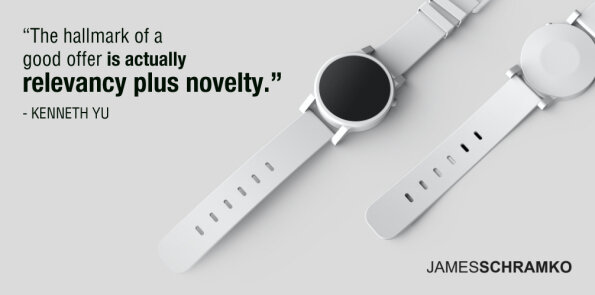In today's world, it can be tough to stand out from the crowd. With so much noise and competition, it's more important than ever to have an offer that is irresistible to your audience.
Kenneth Yu’s copywriting format can make your offer the holy grail your prospect needs. Tune in and discover more.
Podcast: Download (Duration: 42:52 — 43.3MB)
Get Notified Of Future Episodes Apple Podcasts | Spotify | Amazon Music | Android | Blubrry | Gaana | TuneIn | Deezer | Anghami | RSS | More
Episode highlights:
Who is Kenneth, and why should we listen to his copywriting ideas? [02:10]
This is what sets the holy grail concept apart and makes it such effective copywriting… [10:14]
What is the bleeding thumb of your market and how can you fix it? [15:17]
Give people the result they’re looking for, in a way they don’t expect. [19:05]
See where the economy is heading, and ride the wave. [24:45]
Starting with the market and creating a product to fit… [30:29]
Consider Kenneth’s four-part copywriting framework for putting your offer on the page. [33:00]
Who is most likely to benefit from what Kenneth has to teach? [38:11]
Up your marketing game with help from James
Effective copywriting is not a new topic on this podcast. Our latest guest expert, however, A-list copywriter Kenneth Yu, promises to bring a new angle to it. The subject of James’s chat with Kenneth is something called holy grail offers, which will gain meaning during the episode.
But before that, for the benefit of new listeners, just what is copywriting?
“Copywriting is basically salesmanship in print.” – Kenneth Yu
Copywriting is basically salesmanship in print, says Kenneth, as opposed to verbal sales. And in copywriting as in spoken sales, word choice is very important, because certain words connote certain emotions that lead to certain buying decisions. Copy helps you trigger the right emotions that will send your prospects over the hurdle into being customers.
Why Kenneth knows what he’s talking about
Kenneth has worked for some big clients, among them Agora, Mindvalley and McDonald’s. That last one fascinates James – what kind of copywriting could Kenneth have done there?
It was an alternate application of copywriting, says Kenneth – not for their sales, actually, but for the fast food giant’s internal staff. Their own staff had issues with the brand and needed selling on it. Kenneth helped them reverse a 110 percent attrition rate.
That brings up a great point, says James. You often see a warning about copywriting training, that you have to be careful to use what you learn for ethical purposes. Because you can really get people to do things you want.
You can use it on kidnappers, says Kenneth.
That’s one James and the audience have to hear.
About 20 years ago, college student Kenneth got kidnapped with a friend. Some guys in a car asked them to get in and direct them to the nearest mall, and being, in Kenneth’s words, young and stupid, they did. The kidnappers drove them someplace rural and robbed them at knifepoint.
Where the copy comes in is, Kenneth spoke with one of their captors and convinced him to give back phone and wallet, and even provide train fare for the way back. Instead of throwing them into some field, the robbers dropped the students at the train station, pretty much unscathed.
Does Kenneth remember the gist of what he said?
He basically said he was harmless, and that the kidnapper’s face was generic enough that they couldn’t be pinpointed. They’d gotten the pair’s money, so it wouldn’t hurt for them to return Kenneth’s wallet and phone and a few bucks for the train. It was the power of reciprocity.
Interesting, says James. He’d had a few dangerous run-ins himself, in the line of debt collection. One person threatened to kill him with a knife. James made it out of that encounter with the guy’s repossessed car in tow.
Now it’s not often as a copywriter that one finds themselves in a life-threatening situation, though the great John Carlton does speak of the gun-at-their-head technique for coming up with ideas.
“Basically, for a lot of us, we are externally motivated.” – Kenneth Yu
Basically, for a lot of us, says Kenneth, we are externally motivated. He does find with a copywriting deadline that he comes to life. Just a week before, someone paid him $50K for a sales letter, delivery in three weeks. That made him so happy.
What’s so special about holy grail copywriting?
James has always taught people, not much is going to happen until you find your offer that converts. And that is the biggest place he sees students struggle. So what’s different about Kenneth’s holy grail copywriting that addresses that?
His strategy, Kenneth says, is largely about talismans. Talismans are an object you outsource your belief to because it can produce a benefit or a result. The holy grail is one, a cup said to give immortality if you drank from it. In the legends, King Arthur and his knights went after the grail, and all died. It was that precious to them. Now, can your product or service be that cup, that holy grail?

So how do you position your service or product as a talisman so that it sells itself, or so that, when you sell it with all the copywriting strategies, everything, the result is amplified?
So essentially, you make your offer so desirable that people feel it will be the big difference for them compared to anything else out there, says James. Is that like putting yourself in your own category?

Does your offer address a bleeding thumb?
Now, relevancy, that is, what is the desire of the market? Or, what is the moving pain? What is the urgent pain point that will drive the prospect?
Kenneth gives a somewhat gory example. Again when he was young and stupid, he tried to pry apart some frozen burger patties and almost chopped off his thumb. He could see bone, and blood was everywhere. At that time, the thought in his head that overrode nearly all else was to get to the doctor downstairs.
A lot of people, says Kenneth, are trying to sell things where there is no bleeding thumb. Take those who want to build a membership around an idea. Kenneth has to say, Hang on – is this something people actually have a problem with? Is there enough pain in the marketplace?
And especially with memberships, says James, you have to consider: is it an ongoing problem, or a one-off thing, like with the plumber or the divorce lawyer? After getting his thumb fixed, wouldn’t Kenneth have gone back to dealing with his regular doctor, instead of the nearest option?
Yes, although Kenneth does know people who’ve made a career out of bleeding thumbs. One of his friends handles emergency IT support for Facebook, Google and the like, because they find her more accessible than Global.
Giving people a solution they don’t expect
So we want to make sure our offer is relevant, James says. And we want to make sure that it’s novel.

An instance of looking to the past would be in personal development. There’s a current fascination with the ancient, the perception that it’s actually superior to the modern. And several products out there teach mindfulness through emulating the ancient Indian yogis, with practices such as meditation. That’s the novelty, paired with the relevancy that people are stressed and are seeking relief through mindfulness.
Then there’s the present. An example would be an immunity supplement that Kenneth offers. It caught his interest that something called immunity deficit is affecting kids worldwide. Due to the restrictions of COVID, their immune systems haven’t developed, putting them in danger should they come down with, say, the flu. So the relevance of the product is to prevent illness, and the novelty is the immunity deficit kids are now experiencing.
For a future example, you can look at crypto. It operates on greed, people wanting to build future wealth. So relevance is, you’re greedy, you want to 10X your gain. And to do that, you invest in Web 3 coins.
Creating an offer by riding the waves
So once you’ve got the past, the present, the future, and are looking at the relevance and the novelty, where do you go from there?
“Where the economy is heading, you just position yourself there.” – Kenneth Yu
Then you create the offer, or you position your service, says Kenneth. And it’s a lot is like building a surfboard business, meaning you ride the waves. Where the economy is heading, you just position yourself there.
That’s what James has done his whole life. In early ’90, ’91, during a recession in Australia, he was a debt collector. As the situation improved, he went into prestige cars, then luxury cars. Then in 2008, just as things crashed and luxury was not the place to be, he moved into online business. This was a good place to be during the pandemic, having done for five to seven years what everyone else was just about to discover.
For some other businesses, there are seasonal considerations. You can’t rent out snow gear in summer, and an ice cream stand may do poorly in the winter. And James has learned as an affiliate that the offer fades at some point. So how closely tied is novelty to fad or trend?
Kenneth thinks trends and fads give you the greatest amount of leads or sales in the shortest amount of time. But you still need to rethink it when the trend fades. Because trends do fade.
What comes first, the market, or the product?
Kenneth has worked for brands like Heineken, The Economist, DHL. In coming up with strategy after strategy, does he have a checklist, or a methodical process? Or is he just ad hoc?
There is a methodical copywriting process, says Kenneth. It’s a five-step holy grail process, three days’ worth of content. Really, he just looks at novelty and relevancy. And the trick is, he doesn’t try to retrofit the product most of the time. He creates the product based on the relevancy and the novelty, because he can.
Is it the ideal way, James asks, to start with the market and then create the product to fit, instead of trying to find people to sell a product that you think is a great idea?
Yes, it’s a Z to A approach for Kenneth, that he uses for everything.
It’s an exciting process, James thinks. It allows you to come up with angles and ideas that get you to the offer. And offer really is everything.
The matter of getting it on the page
Now when you’ve got your offer and your angle, and you’ve got an idea, where people tend to get stuck next is getting it on the page. Formatting, templates, services. How does Kenneth approach it? Does he start with a blank computer screen? Does he have a layout that he likes to follow? Does he pay someone to do it? What’s the advice there?
Kenneth will always use his own holy grail templates, of which he’s created a bunch that are proven to work well. One copywriting framework goes: sin, salvation, heaven, hell. Sin is the problem, salvation is the solution, heaven is the offer and hell is the consequences. He’ll illustrate it with something everyone’s familiar with, weight loss.
So sin will be, you’re overweight and want to fit into your wedding dress in two months.
Salvation is a weight loss coffee that will let you lose five pounds a week if you drink it.
Heaven is the offer – for $37, you get the coffee delivered to you monthly.
Hell is, if you don’t take the offer, how will you fit into that dress in two months?
James loves it. And where does proof come in? What do people do if they’re trying to create an offer but it’s new and they don’t have case studies or testimonials yet? Does that ever happen?
It does, says Kenneth. So he usually gives out stuff for free to get a testimonial. Or because people can be lazy, he might write the testimonial for them, and have them sign off. He wouldn’t do it though for weight loss or medical products – for those, he would collect testimonials.
The other way to do it is with Zoom calls, because people tend to act better in real time. So on a quick call, you interview them. Kenneth usually calls it the T three testimonial process, which is terrible past, try product, a terrific future. So you talk about the terrible past, what’s life like without the product – the more emotional, the better. Then try the product, where you actually try the program. And then terrific future is the after effects, what are the kinds of exciting things you’re doing now because of the product?
Who should be learning from Kenneth’s stuff?
Who does Kenneth think should be learning from him?
Predominantly business owners, because especially online business owners are copy-driven anyway.
And what’s interesting is, one of the biggest buyers of his programs is men above 51. He doesn’t know why.
James has an idea, as someone who fits the category age-wise. He commonly hears people in his peer group say they’re burnt out, bored, feeling like the thing they were doing has stopped working, that they’ve lost touch or feel irrelevant.
On the positive side, maybe they’ve got time and money freedom that they didn’t have before. And now, they like to learn things. James himself is doing courses ongoing, because he has a duty of care to his clients to be on point, to have his finger on the pulse.
In summary, the holy grail concept is positioning your offer as a standalone, absolutely have to have thing that the prospect will desire. And you do that by being relevant and having novelty, by looking to the past, the present, and the future for angles that will make it special.
If you want help positioning, branding and scaling your product or service, check out Kenneth’s site.
Join the community of like-minded entrepreneurs inside the James Schramko membership
Liked the show? Leave us a review on iTunes








Leave a Reply